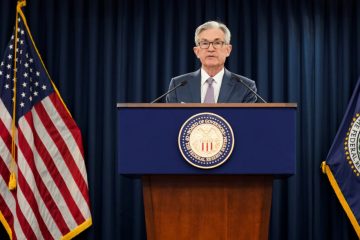U.S. dollar slides as markets re-evaluate Fed rate path

The U.S. dollar slipped on Friday and was on track for its first weekly decline this month, as traders dialed down bets on where interest rates may peak and brought forward their views on the timing of interest rate cuts to counter a possible recession.
A significant factor this week has been the fall in oil and commodity prices, which has eased inflation fears and allowed equity markets to rebound. This has eroded the safe-haven bid that has been boosting the dollar against other major currencies.
“Falling commodity prices could help pull headline inflation prints downward – particularly into the autumn months – reducing the need for aggressive monetary tightening,” said Karl Schamotta, chief market strategist at payments company Corpay in Toronto.
“Mid-curve interest rate expectations are also falling as market participants bet the Fed will overtighten in response to rising consumer inflation expectations – and then be forced into reversing direction,” he added.
U.S. rate futures priced in a 73% probability of a 75 basis-point increase at the July meeting. For September the market has factored in a 50-bps rise.
In afternoon New York trading, the dollar index, which measures the U.S. unit against six major currencies, fell 0.3% to 104.13.
The safe-haven greenback slipped further after data showed new home sales jumped 10.7% to a seasonally adjusted annual rate of 696,000 units last month. May’s sales pace was revised higher to 629,000 units from the previously reported 591,000 units.
The University of Michigan consumer sentiment survey showed mixed results, with sentiment worsening in June to 50, from a final reading in May of 58. But the reading on five-year inflation expectations eased to 3.1 from the preliminary 3.3% estimate in mid-June.
The dollar, up around 9% this year, has lost some of its shine since investors started betting the Fed could slow the rate-tightening pace following another 75 basis-point increase in July. They now see rates peaking next March around 3.5% and falling nearly 20 bps by July 2023.
This rate hike repricing sent 10-year Treasury yields to two-week lows, while the dollar index has lost 0.5% this week.
For now though, Fed Chair Jerome Powell stressed the central bank’s “unconditional” commitment to taming inflation. Fed Governor Michelle Bowman also supported 50 bps hikes for “the next few” meetings after July.
Analysts noted terminal rate repricing across the developed world as recession fears grow.
“The repricing in the market … has held the dollar back but an offsetting force is the risk of a global downturn. The Fed is pretty much on autopilot. Until they take their foot off the brakes, dollar weakness will be limited,” BMO Capital Markets strategist Stephen Gallo said.
“Rate hikes are being taken out of the euro and sterling markets too,” he noted.
The Japanese yen, sensitive to changes in U.S. yields, was down roughly 0.2% at 135.19 per dollar.
The euro rose slightly to $1.055.
The greenback’s slide boosted even commodity-focused currencies such as the Australian dollar and Norwegian crown. The Aussie ticked up 0.7% to US$0.6943, though it remained on track for a third straight weekly decline.
The Norwegian crown, fresh off Thursday’s 50 basis-point rate hike, was up about 1% at 9.86 per dollar.
The Swiss franc touched the highest since early March against the euro at 1.0055.


